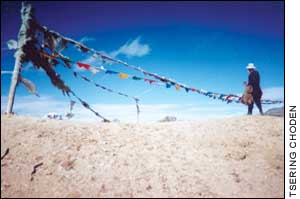 Ever since Tibet opened up to tourists in late 1984, resulting in an influx of eager foreign visitors entering the once closed region, Kathmandu has been a popular entry point to the plateau.
Ever since Tibet opened up to tourists in late 1984, resulting in an influx of eager foreign visitors entering the once closed region, Kathmandu has been a popular entry point to the plateau. And as tourism to Nepal continues to suffer, it is the Tibet traffic that is keeping many Kathmandu hotels in business this monsoon season.
"Tibet has its own particular charm, and it complements a Nepal holiday very well," says Peter Chu, of Arniko Travel. Chu is one of the pioneer operator of tours to Tibet, and began offering overland trips to Tibet nearly 20 years ago. Things have changed in Tibet since that time. "Infrastructure has improved, logistics are better managed. But the asphalt road to the border at Khasa was definitely better, then," he says. The Arniko Highway today is blocked in many places by nasty landslides and these days it takes up to five hours to reach Khasa, a journey that used to take three hours.

Of course, you can bypass the landslides by taking the twice-a-week one-hour flight to Lhasa from Kathmandu. At $255 one-way flight it is steep, but it saves time. Many people fly one way. Opinion is divided over whether it is better to fly there and drive back, or drive there and fly back. Flying straight into Lhasa at 3,600 m can give people problems with altitude, whereas driving first can create acclimatisation problems because the highway first crosses the Thingri Pass at 4,300 m and Shigatse at 3,900 before descending to the Tsang Po plain.
"The high passes make it dangerous for people with problems with the altitude," says Ang Tshering Sherpa of Asian Trekking, which is also the agent in Nepal for China Tibet Mountaineering Association. In April, representatives of the Travel Agents Association Nepal visited the CTMA to talk about the possibility of reducing fees on some peaks and providing transport for climbers right back till Kodari at the Nepal-Tibet border.
With tourist arrivals to Nepal down by 40 percent, tourists and climbers going to Tibet via Nepal have been helping local tour operators keep afloat. "The numbers may have decreased but they are still coming," says Chu whose company handled about 500 tourists last year, compared to the 200 tourists it has handled so far this year.
 The total number of tourists (which includes moutaineers climbing Himalayan peaks on the border from the Chinese side) going to Tibet from Nepal last year was approximately 15,000, and so far this year 7,000 have done so. Tour operators expect a 15 percent drop in Tibet traffic via Nepal this year. As a result, China South West, which operates the Lhasa connection has reduced flights from three a week to two this season.
The total number of tourists (which includes moutaineers climbing Himalayan peaks on the border from the Chinese side) going to Tibet from Nepal last year was approximately 15,000, and so far this year 7,000 have done so. Tour operators expect a 15 percent drop in Tibet traffic via Nepal this year. As a result, China South West, which operates the Lhasa connection has reduced flights from three a week to two this season. However, to offset the drop, there has been a spurt in Indian tourists to Tibet, most of whom are bound for Mansarovar and Mt. Kailash. "That's a major emerging market which needs to be tapped specially in times when the numbers of third country arrivals are decreasing," says Ang Tshering Sherpa. Truckloads of devout Buddhists have also made their way to Kailashfor the Sakhedawa festival which is held every 12 years .
The alternative route is for pilgrims to fly to Nepalgunj and Simikot, and walk to Hilsa on the Nepal-Tibet border. From the border it is a four-hour drive to Mansarovar, and another four hours to the base of Mt Kailash. People continue to take this route despite the presence of Maoists-for a price. Travellers who recently made the round-trip journey to Kailash via Simikot told us that the Maoists have a sliding scale for the "donations" required to pass through the area, ranging from $100 per head for foreigners, to Rs 7,000 for Indians.
While Indian pilgrims are keen to get close to Kailash as quickly as possible, other tourists, apart from the classical seven-day Lhasa trip, have cycling tours, cultural tours to choose from. Among the most popular are the 10 day expedition to the north base camp of Mt Everest, 10 day trans Himalaya Tibet tour, 12 day Lhasa-Tsedang-Sangkagutok-Gyantse-Zhangmou. With the area east of Lhasa opening up, the tours are gaining in popularity. Not much is restricted and it is possible to travel virtually anywhere in Tibet now.
The flooding of the market with cheap tours has led to cost cutting phenomenon also seen in Nepal, and has been hurting the travel agencies in Nepal. Despite an increase in volumes, they say the profit margin is getting less.
Nepal may be 20 or 30 years ahead of Tibet in terms of tourism development, and many Nepali companies still provide the expertise and logistics required to run tours and mountaineering expeditions in Tibet. But as China builds up it own tourism potential, this could soon change. There is talk of Nepali climbing support teams being replaced by entire teams from Tibet itself.


